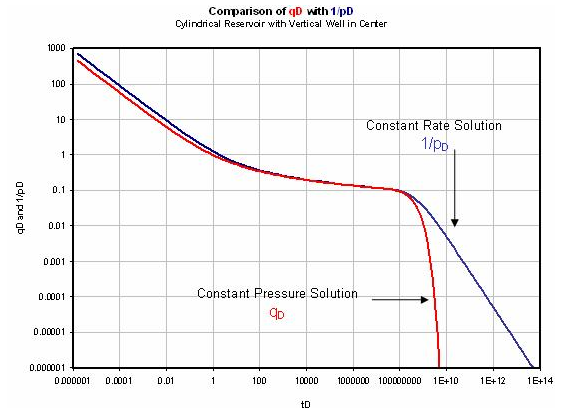A well produced at a constant rate exhibits a varying (declining) sandface flowing pressure, whereas a well produced at a constant sandface pressure exhibits a varying decline rate. There is a strong symmetry between the two solutions, as both are obtained from the same equation, namely the equation that governs fluid flow in porous media. The symmetry is not exact, however, because the boundary conditions under which the two solutions are obtained are different.
The constant rate solution can be converted to a constant sandface pressure solution (and vice versa) using the principle of superposition. The constant sandface pressure solution is obtained by superposing a large number of very short constant rate solutions in time. When plotted against superposition time, the superposed constant rate solution is very similar to the constant pressure solution, provided the discretization intervals are sufficiently small. It turns out that the two solutions are quite similar during transient flow anyway, and therefore, superposition is not required to make one look like the other. However, they quickly diverge after boundary-dominated flow begins. The constant rate solution behaves like the harmonic stem of the Arps type curves, while the constant pressure solution declines exponentially. The figure below compares the two solutions by plotting the dimensionless typecurves of each.

A method for forcing one solution to look like the other during boundary-dominated flow is useful because the necessity of using superposition in time would be avoided completely. Because of pressure transient analysis, diagnostic tools for analyzing the constant rate solution are widely known and understood. Therefore, there is value in being able to analyze other types of solutions using the same diagnostic tools. The concept of material balance time provides the normalization necessary to make constant pressure and constant rate solutions equivalent. Material balance time converts the boundary-dominated flow portion of the constant pressure solution into the pseudo-steady state portion of the equivalent constant rate solution. Plotting using material balance time also allows solutions with both declining rates and pressures to look like the equivalent constant rate solution.